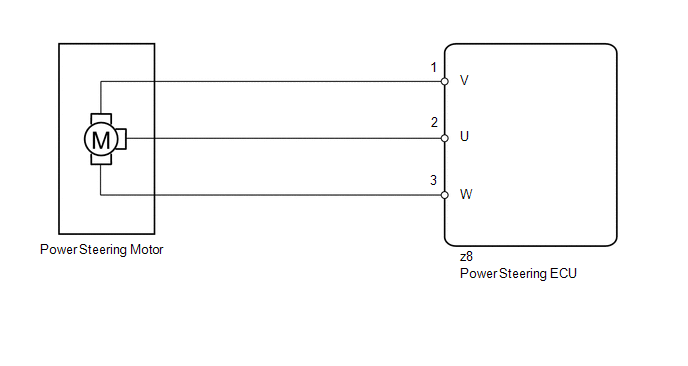Toyota Venza: Motor Circuit Malfunction (C1522-C1555)
DESCRIPTION
The power steering ECU supplies current to the power steering motor through the motor circuit.
|
DTC No. |
DTC Detection Condition |
Trouble Area |
|---|---|---|
|
C1522 |
Motor current sensor malfunction |
|
|
C1523 |
Excessively large current deviation |
|
|
C1524 |
Short (or open) in motor circuit or abnormal voltage or current in motor circuit |
|
|
C1555 |
Motor relay failure |
WIRING DIAGRAM

CAUTION / NOTICE / HINT
NOTICE:
If the power steering ECU and steering column assembly have been replaced, perform
the rotation angle sensor initialization and torque sensor zero point calibration
(See page .gif) ).
).
PROCEDURE
|
1. |
READ VALUE USING TECHSTREAM (MOTOR VOLTAGE) |
(a) Turn the ignition switch off.
(b) Connect the Techstream to the DLC3.
(c) Turn the ignition switch to ON.
(d) Turn the Techstream on.
(e) Enter the following menus: Chassis / EMPS / Data List.
(f) Select the items "Motor Terminal Volt(U)", "Motor Terminal Volt(V)" and "Motor Terminal Volt(W)" in the Data List and read the value displayed on the Techstream.
EMPS|
Tester Display |
Measurement Item/Range |
Normal Condition |
Diagnostic Note |
|---|---|---|---|
|
Motor Terminal Volt(U) |
Motor terminal voltage (U phase)/ Min.: 0 V Max.: 46.667 V |
During steering operation, value changes within 4 to 46 V range |
The engine is running and steering wheel is being turned. |
|
Motor Terminal Volt(V) |
Motor terminal voltage (V phase)/ Min.: 0 V Max.: 46.667 V |
During steering operation, value changes within 4 to 46 V range |
The engine is running and steering wheel is being turned. |
|
Motor Terminal Volt(W) |
Motor terminal voltage (W phase)/ Min.: 0 V Max.: 46.667 V |
During steering operation, value changes within 4 to 46 V range |
The engine is running and steering wheel is being turned. |
|
Result |
Proceed to |
|---|---|
|
During steering operation, value changes within 4 to 46 V range |
A |
|
During steering operation, voltage is not generated |
B |
| A | .gif) |
REPLACE POWER STEERING ECU |
| B | .gif) |
REPLACE STEERING COLUMN ASSEMBLY |
 Vehicle Speed Signal Malfunction (C1541)
Vehicle Speed Signal Malfunction (C1541)
DESCRIPTION
The power steering ECU receives vehicle speed signals from the brake actuator
assembly (skid control ECU) via CAN communication. The ECU provides appropriate
assisting force in accord ...
 Torque Sensor Zero Point Adjustment Incomplete (C1516,C1526)
Torque Sensor Zero Point Adjustment Incomplete (C1516,C1526)
DESCRIPTION
These DTCs do not indicate a malfunction. The power steering ECU stores these
DTCs when it determines that the rotation angle sensor value initialization and
torque sensor zero point ...
Other materials about Toyota Venza:
Diagnosis System
DIAGNOSIS SYSTEM
1. DESCRIPTION
(a) When troubleshooting a vehicle with a diagnosis system, the only difference
from the usual troubleshooting procedure is connecting the Techstream to the vehicle
and reading various data output from the clearance warnin ...
Reassembly
REASSEMBLY
PROCEDURE
1. INSTALL FRONT BLOWER MOTOR SUB-ASSEMBLY
(a) Install the front blower motor sub-assembly with the 3 screws.
2. INSTALL AIR INLET SERVO MOTOR SUB-ASSEMBLY
(a) Insta ...
Mass or Volume Air Flow Circuit Low Input (P0102,P0103)
DESCRIPTION
The mass air flow meter is a sensor that measures the amount of air flowing through
the throttle valve. The ECM uses this information to determine the fuel injection
time and to provide the appropriate air-fuel ratio.
Inside the mass air flow ...
0.1684
